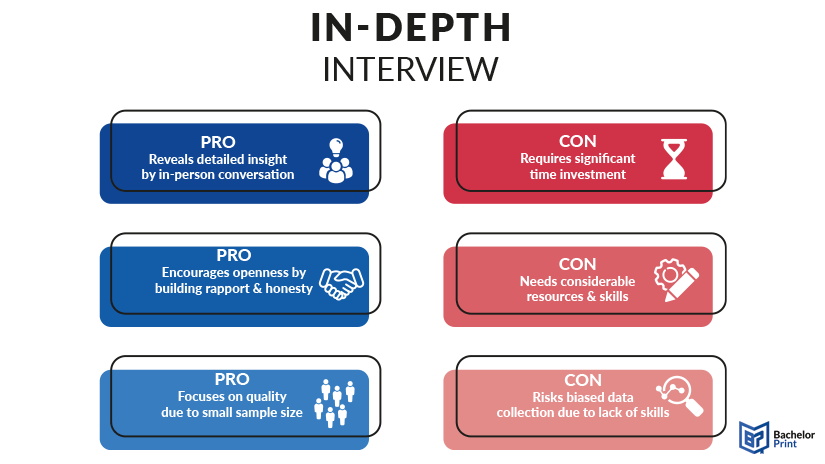
In-depth interviews are a cornerstone of qualitative research, offering meaningful insights into a participant’s experiences and motivations that cannot be collected by a simple survey research. This method involves conducting one-on-one conversations that delve deeply into the subject. This article examines the methodology behind in-depth interviews, highlighting their design, implementation, and the unique advantages they offer in capturing the intricacies of human thought and behavior.
Definition: In-depth interview
In-depth interviews, also called IDIs or one-on-ones, are a qualitative data collection method characterized by detailed, one-on-one conversation between a researcher and a participant. The primary purpose is to explore complex phenomena through the eyes of the interviewee, gaining rich insights into their perspectives, personal experiences, thoughts, and feelings. In a successful in-depth interview, the interviewer is predominantly listening rather than talking, while also taking note of the participant’s body language.
Unlike structured surveys or questionnaires, IDIs use open-ended questions that allow participants to express their thoughts freely and provide detailed responses. This approach is particularly useful for exploring sensitive topics where participants may feel more comfortable discussing issues in a private setting. This allows the researcher to gain a fleshed-out understanding of individual, detailed experiences and perspectives and develop hypotheses for further quantitative research.
Characteristics of in-depth interviews
Key characteristics of in-depth interviews include the following:
- Depth: Open-ended questions allow participants to express their thoughts freely, and provide detailed and nuanced responses. This, combined with follow-up questions, ensures a collection of rich, detailed data and an understanding of the participant’s point of view by focusing on the “why” and “how” behind behaviors.
- Semi-structured: In-depth interviews typically follow a semi-structured format, using a guide to cover key topics while allowing flexibility for the conversation to flow naturally based on participants’ responses.
- Personal interaction: Building rapport and trust is crucial, as the interviewer’s interpersonal skills help create a comfortable environment for participants to share openly. These skills indicate a person when to ask a sensitive question, probe more deeply, or when to move on.
Types of interviews
Research interviews can be divided into three types of structure: structured, semi-structured, and unstructured. In-depth interviews usually fall in-between unstructured and semi-structured interviews due to their flexibility. Each interview style will be explained below.
A structured, often formal interview process follows a predetermined set of questions, ensuring consistency across all interviews. The structured interview format minimizes interviewer bias and allows for easier comparison of responses but may limit the depth of key insights as there is less flexibility to explore brand-new topics.
Semi-structured interviews use a guide with key topics and questions, but the interviewer has the flexibility to deviate based on the participant’s responses. This format balances consistency with depth, allowing for detailed data while maintaining some level of structure.
Unstructured interviews, also called non-directive interviews, are highly flexible and conversational with no predetermined questions or format. The interviewer explores topics by probing, as they arise naturally during the conversation. This allows for the deepest, personal insights and a thorough understanding of the participant’s perspective.
However, this format can be time-consuming and challenging to analyze due to its lack of consistency. One specialized form of this unstructured interview approach is the narrative interview, which focuses on eliciting personal stories, similarly to a free-flowing conversation driven by the participant’s responses.
Below is an image encompassing all three types of interviews and what they can be used for.

Focus groups
Focus groups are considered a type of qualitative interview method, though they differ significantly from individual in-depth interviews. Focus groups involve group discussions led by a moderator, where multiple participants interact with each other to discuss a specific topic or set of topics. The gathered responses can guide future research on consumer products, human behavior, or controversial topics.
In-depth interview guide
Below, you’ll find the three most important steps,to successfully conduct an IDI.



1. Preparation
Clearly outline the goals of the interview and what you hope to learn from it. Create a semi-structured guide with key topics and open-ended questions to steer the conversation while simultaneously allowing flexibility. You should choose participants who are relevant to the research topic and can provide valuable insights.
It’s vital to arrange a time and place that is convenient for the participant, ensuring privacy and minimal distractions. The SMART goal framework might also help ensure that your interviews are well-structured and that you have a broad idea of what’s to come.
2. Conducting the interview
Start by making the participant feel at ease in a comfortable interview environment. Explain the purpose of the interview, ensure confidentiality, and establish a non-judgmental tone. Begin with broad questions and follow up with more specific ones. Pay close attention to the participant’s responses, showing interest and understanding. Use both verbal and non-verbal cues to encourage them to continue.
Don’t forget to ask follow-up questions to delve deeper into interesting points. Avoid leading questions or expressing your own opinions, as the focus should be on the participant’s perspective. With permission, record the interview for accurate data collection and take detailed notes of any immediate thoughts or observations.
3. Post-interview
Express gratitude for their time and reiterate the confidentiality and how their input will be used. Listen back to recordings for each detailed interview or convert the recording into a written transcript. You can also bookmark different parts that you think are important. Analyze the data by using methods such as thematic analysis to identify patterns from the qualitative data. Reflect on your findings and how they contribute to the research objectives.
Pros and cons
IDIs give researchers valuable, nuanced insights into people’s thoughts and expectations. In this paragraph, we have listed both benefits and challenges that can arise.
Benefits
Three benefits of in-depth interviews are listed below.
- Depth of detailed insight: Face-to-face IDIs, whether in-person or online, allow for detailed exploration of complex topics by asking follow-up questions. Interviewers can interpret body language and analyze changes in tone of voice and word choice can reveal in the meanings behind responses.
- Building rapport: The one-on-one setting helps build trust and rapport with participants, which encourages openness and honest feedback, as peer-pressure might occur in larger focus groups and diminish valuable insights. Thus, there is no room left for someone to influence the interviewee’s opinions.
- Quality over quantity: A smaller sample size enables researchers to prioritize the quality of the data over the quantity. Each interview can be more thorough, and the individual insights gained can be richer and more nuanced.
Challenges
Three challenges that can arise can be found below.
- Time-consuming: In-depth interviews can be very time-consuming, both in terms of conducting the interviews and analyzing the obtained data. Even though IDIs are very informative, they require more time, preparation, and skills than other research methods.
- Resource-intensive: They often require considerable resources, including skilled interviewers, recording equipment, and software for transcription and analysis. This can make them expensive and logistically challenging for the researchers.
- Interviewer bias: The quality and depth of the data collected can be influenced by the interviewer’s skills, biases, and interactions with the participant. Poor interviewing techniques can also lead to incomplete or biased data due to accidental influence on responses.

FAQs
An in-depth interview typically lasts between 30 minutes to 60 minutes each, depending on the topic and depth of discussion.
Advantages:
- Provides rich, detailed insights
- Flexible and adaptive to participants’ factual responses
- Builds strong rapport, encouraging honest feedback
Disadvantages:
- Time-consuming and resource-intensive
- Potential for interviewer bias and subjective analysis
- Requires a very skilled interviewer
A narrative interview focuses on eliciting a participant’s life story or personal experiences in a chronological, storytelling format. An in-depth interview, on the other hand, explores specific topics in detail, using a semi-structured or unstructured format to delve deeply into lived experiences.
Yes, in-depth interviews are highly flexible, allowing interviewers to adjust questions and follow up on interesting points based on the interview participants’ honest responses. This adaptability helps uncover more in-depth insights and explore unexpected topics.